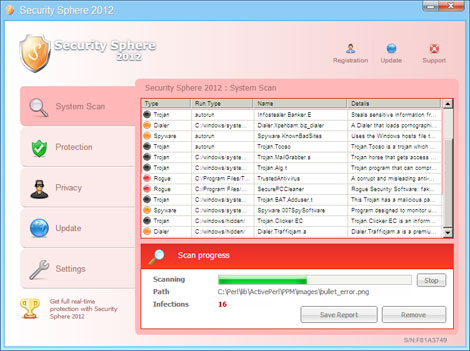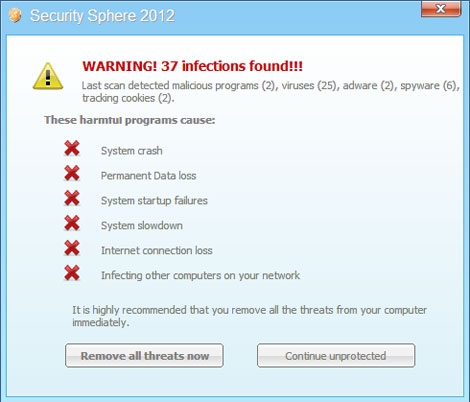TROJ_FAKEAV.BLO
Windows 2000, Windows XP, Windows Server 2003


Threat Type: Trojan
Destructiveness: No
Encrypted: Yes
In the wild: Yes
OVERVIEW
This Trojan may be downloaded by other malware/grayware/spyware from remote sites. It may be dropped by other malware. It may be unknowingly downloaded by a user while visiting malicious websites.
It connects to a website to send and receive information.
It installs a fake antivirus/antispyware software. It displays fake alerts that warn users of infection. It also displays fake scanning results of the affected system. It then asks for users to purchase it once scanning is completed. If users decide to purchase the rogue product, users are directed to a certain website asking for sensitive information, such as credit card numbers.
TECHNICAL DETAILS
Arrival Details
This Trojan may be downloaded by other malware/grayware/spyware from remote sites.
It may be dropped by other malware.
It may be unknowingly downloaded by a user while visiting malicious websites.
Installation
This Trojan drops the following non-malicious files:
- %System Root%\All Users\Application Data\{malware file name}\{malware file name}
(Note: %System Root% is the root folder, which is usually C:\. It is also where the operating system is located.)
It drops the following copies of itself into the affected system:
- %System Root%\All Users\Application Data\{malware file name}\{malware file name}.exe
(Note: %System Root% is the root folder, which is usually C:\. It is also where the operating system is located.)
It creates the following folders:
- %System Root%\All Users\Application Data\{malware file name}
(Note: %System Root% is the root folder, which is usually C:\. It is also where the operating system is located.)
Autostart Technique
This Trojan adds the following registry entries to enable its automatic execution at every system startup:
HKEY_CURRENT_USER\Software\Microsoft\
Windows\CurrentVersion\RunOnce
{malware file name} = %System Root%\All Users\Application Data\{malware file name}\{malware file name}.exe
Backdoor Routine
This Trojan connects to the following websites to send and receive information:
- http://{BLOCKED}.{BLOCKED}.174.27
- http://{BLOCKED}.{BLOCKED}.212.23
- http://{BLOCKED}.{BLOCKED}.212.14
Rogue Antivirus Routine
This Trojan displays the following fake alerts:
It installs a fake antivirus/antispyware software.
It displays fake alerts that warn users of infection. It also displays fake scanning results of the affected system. It then asks for users to purchase it once scanning is completed. If users decide to purchase the rogue product, users are directed to a certain website asking for sensitive information, such as credit card numbers.
NOTES:
It prevent all applications from executing except the following:
- aeadisrv.exe
- alg.exe
- audiodg.exe
- avreinstall.exe
- conhost.exe
- csrss.exe
- ctfmon.exe
- dwm.exe
- explorer.exe
- firefox.exe
- httpd.exe
- iastordatamgrsvc.exe
- iexplore.exe
- lsass.exe
- lsm.exe
- mdnsresponder.exe
- mfnsvc.exe
- nvscpapisvr.exe
- nvsvc.exe
- nvvsvc.exe
- openvpn.exe
- opera.exe
- pdagent.exe
- rundll32.exe
- searchindexer.exe
- services.exe
- slsvc.exe
- smss.exe
- snort.exe
- spoolsv.exe
- svchost.exe
- system
- taskhost.exe
- wininit.exe
- winlogon.exe
- winroute.exe
- wmiprvse.exe
- wscntfy.exe
- wuauclt.exe
SOLUTION
Step 1
For Windows XP and Windows Server 2003 users, before doing any scans, please make sure you disable System Restore to allow full scanning of your computer.
Step 2
Scan your computer with your Trend Micro product and note files detected as TROJ_FAKEAV.BLO
Step 3
Restart in Safe Mode
Step 4
Delete this registry value
Important: Editing the Windows Registry incorrectly can lead to irreversible system malfunction. Please do this step only if you know how or you can ask assistance from your system administrator. Else, check this Microsoft article first before modifying your computer's registry.
- In HKEY_CURRENT_USER\Software\Microsoft\Windows\CurrentVersion\RunOnce
- {malware file name} = %System Root%\All Users\Application Data\{malware file name}\{malware file name}.exe
- {malware file name} = %System Root%\All Users\Application Data\{malware file name}\{malware file name}.exe
Step 5
Search and delete these folders
Step 6
Restart in normal mode and scan your computer with your Trend Micro product for files detected as TROJ_FAKEAV.BLO. If the detected files have already been cleaned, deleted, or quarantined by your Trend Micro product, no further step is required. You may opt to simply delete the quarantined files. Please check this Knowledge Base page for more information.
NOTES:
Recommendations:
- This malware is detected and removed by the latest Trend Micro anti-malware engine and pattern. Always keep pattern files and engines up-to-date. To know more about updating your Trend Micro product’s pattern, please refer to the following Trend Micro support page: Note: The steps apply for specific products indicated in the page.
- To actively detect and protect your machine, enable real-time scanning of your Trend Micro anti-malware product. Refer to the following Trend Micro support page to know more about enabling real-time scanning in your Trend Micro product:
- Enable firewall to protect against threats.
- Be aware of social engineering attacks.
Did this description help? Tell us how we did.






